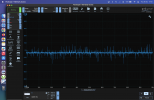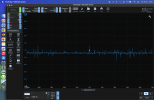Hello, I managed earlier today to measure the bias voltage and it was 5 mV per each channel, pretty much identical on all. As per ONKYO A-9010 service manual, that has the same output stage transistors and recommends 8 mV for biasing, I increased each channel's bias voltage to 8 mV. I've use my multimeter, but later I checked with my PicoScope as well, due to my rather poor resolution for mV measurements to my BRYMEN BM257s.
Per the above and knowing that the emitter resistances are 0.22 Ohms each, then
I = U/R = 5mV/440mOhms = 11mA. After bias increase I got
18mA idling current on each channel, which will increase a little bit more idling power consumption and will also warm up the output stage a little bit more (1-2C while idling).
At 21.5 W I got about the same SINAD results, meaning that increasing the bias current for the output stage has no influence for output power of 20 W and probably neither for above 20 W, suggesting that this AV Receiver is setup to operate around the SINAD of 80 dB for each channel, meaning a THD+N of 0.01%.
After increasing the bias voltage I haven't got time to measure the SINAD with ECO Mode Off, but given that the bias voltage looks pretty much the same as initially I don't think there will be any noticeable difference.




